Doctors at Tu Du Hospital and Cho Ray Hospital performed electric shocks 7 times before and after the cesarean section to help save the life of mother and child of mother D.TT (36 years old, living in Thuan An, Binh Duong ) with severe atrial fibrillation - atrial flutter.
On March 10, specialist doctor 2 Tao Tuan Kiet, Head of the Department of Anesthesia and Resuscitation, Tu Du Hospital, said that the team of two hospitals had coordinated a successful cesarean section for a case of complex heart disease including atrial fibrillation, atrial flutter, heart failure, peripartum cardiomyopathy not excluding paroxysmal supraventricular tachycardia, helping to give birth to a healthy baby girl weighing 2,600g.
Medical history showed that Ms. T. had given birth naturally once in 2019; this time she got pregnant naturally, and had multiple prenatal check-ups at the local hospital as scheduled. In the first 3 months, she had a high-risk NIPT screening test, followed by an amniocentesis, which showed normal chromosome results. When the pregnancy was 32 weeks and nearly 36 weeks, Ms. T. went for a routine prenatal check-up, which recorded a pulse of 177 - 179 beats/minute, and she still did not feel short of breath or tired. Upon closer inspection, Ms. T. felt a slight palpitations. The obstetrician recommended that Ms. T. see a cardiologist at a tertiary hospital.
On the morning of March 3, at Cho Ray Hospital, the doctor recorded that Ms. T. had supraventricular tachycardia, 3/4 mitral valve regurgitation, pericardial effusion, left ventricular failure, atrial fibrillation - atrial flutter - peripartum cardiomyopathy. Ms. T. was given cardiac medication, heart rate stabilization, and was advised to be admitted to Tu Du Hospital to terminate the pregnancy.
After consultation between the Anesthesiologist of Tu Du Hospital and the Arrhythmia specialist of Cho Ray Hospital, Ms. T. was treated with intravenous drugs to stop the tachycardia, but after 10 minutes there was no result. The electrocardiogram during the injection showed a transient atrioventricular block and a slight drop in blood pressure. So immediately after that, the doctors decided to perform electric shock.
Electric shock before and after cesarean section
Immediately the defibrillator and necessary supportive drugs were ready. After injecting the anesthetic, the team performed the defibrillator with a single-phase defibrillator and an energy level of 100J. After 10 minutes, the situation did not improve, the doctors decided to perform a second defibrillator with a higher energy level of 150J. After 10 minutes of close monitoring, the pulse was still 184 beats/minute, blood pressure was 110/84 mmHg, the doctors quickly consulted and decided to perform a third defibrillator with an even higher energy level of 200J.
After every 10 minute cycle, the doctors' faces tensely looked at each other after seeing the heart rate monitor still showing no change, decided to shock the patient a fourth time with an energy level of 300J but still had no results and then finally shocked the patient a fifth time with the maximum energy level of the machine 360J still had no results.
Faced with Ms. T's critical condition due to not responding to treatment, we continued to consult extensively with Cho Ray Hospital doctors to coordinate an emergency cesarean section.
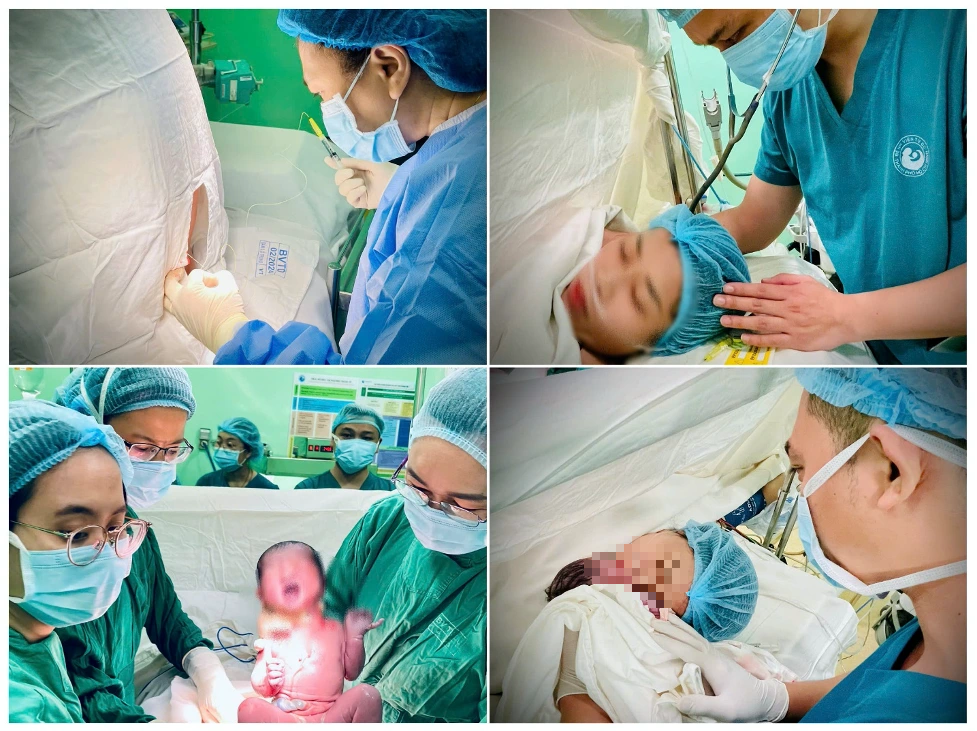
Ms. T. received epidural anesthesia and successfully had a cesarean section.
"Faced with a complicated heart condition like Ms. T.'s, to perform a cesarean section, considering which method is most suitable is extremely difficult. If general anesthesia is chosen, the post-operative recovery period will be extremely complicated, and if local anesthesia is chosen, it will be difficult to control the respiratory circulation well. After careful consideration, the doctors decided to perform epidural anesthesia for the cesarean section," said Dr. Kiet.
The surgery was performed at 6 p.m. on March 3rd and after 10 minutes a healthy baby girl weighing 2,600 grams was born, crying loudly, with rosy skin. Before and during the surgery, doctors had to use many types of drugs to control the arrhythmia and heart failure. Finally, the surgery was temporarily safe and ended after 1 hour.
After transferring Ms. T. to the intensive care unit, her pulse was still fast, so the doctors decided to shock her for the 6th time. However, after 10 minutes, the results still did not improve. Gathering all their courage, the doctors decided to shock her for the 7th time with an energy level of 200J. After 10 minutes, her pulse had decreased to 160 beats/minute. Although the results were not as expected, the doctors decided to stop the shock and continue to control her pulse with medication.
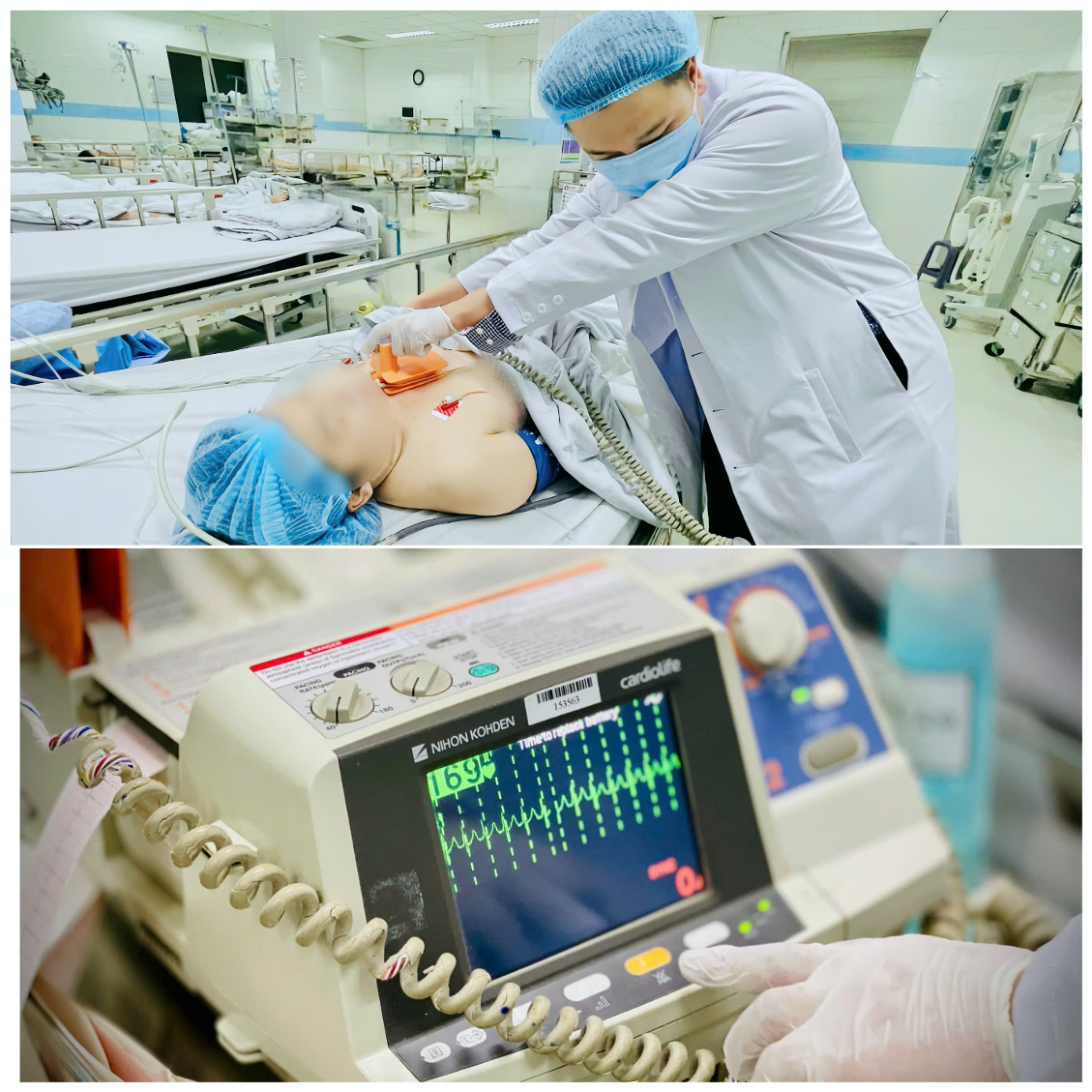
The patient was given electric shock by doctors in the resuscitation room.
Radiofrequency ablation of the heart to treat heart disease in mothers
One day after surgery, the patient's general condition was better, the incision was dry, and there was not much pain. The pulse gradually decreased to 120 - 130 beats/minute, she was much healthier, able to eat and drink, and her obstetrics were stable, so the doctors decided to transfer Ms. T. to the Arrhythmia Department, Cho Ray Hospital, to continue treatment with radiofrequency ablation. To find the arrhythmia focus, the doctors will perform a 3D anatomical - electrical reconstruction of the heart chamber, accurately detecting the arrhythmia focus from the anterior wall of the left atrium, where the left superior pulmonary vein flows into. From there, the doctors will ablate with radiofrequency waves to create scars that cut off conduction.
After the surgery, Ms. T.'s health stabilized, returning to a normal heart rate of 80-90 beats/minute. The doctors were extremely happy to have brought Ms. T.'s heart rate back to a normal physiological level like many people's heart rates. After the surgery stabilized for 24-48 hours, Ms. T. will be transferred back to Tu Du Hospital for post-operative monitoring for another 1-2 days and is expected to be discharged with her baby in the near future.
Source: https://thanhnien.vn/soc-dien-7-lan-cuu-san-phu-mac-benh-tim-duoc-me-tron-con-vuong-185250310094919679.htm




![[Photo] Hanoi morning of October 1: Prolonged flooding, people wade to work](https://vphoto.vietnam.vn/thumb/1200x675/vietnam/resource/IMAGE/2025/10/1/189be28938e3493fa26b2938efa2059e)
![[Photo] Keep your warehouse safe in all situations](https://vphoto.vietnam.vn/thumb/1200x675/vietnam/resource/IMAGE/2025/10/1/3eb4eceafe68497989865e7faa4e4d0e)
![[Photo] President of the Cuban National Assembly visits President Ho Chi Minh's Mausoleum](https://vphoto.vietnam.vn/thumb/1200x675/vietnam/resource/IMAGE/2025/10/1/39f1142310fc4dae9e3de4fcc9ac2ed0)





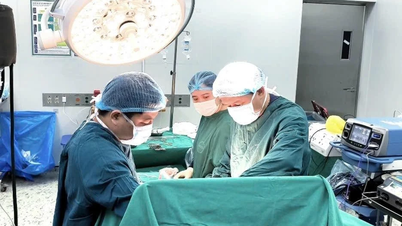

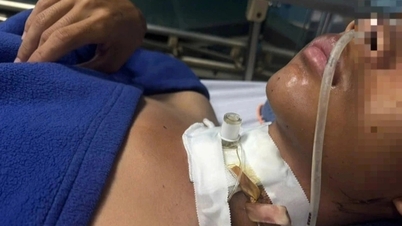





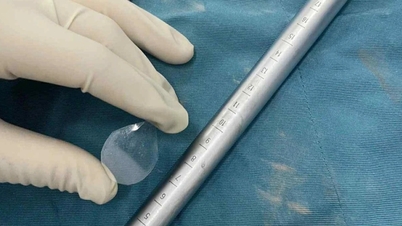
















































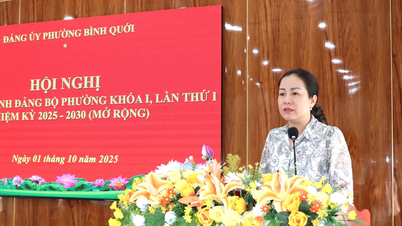
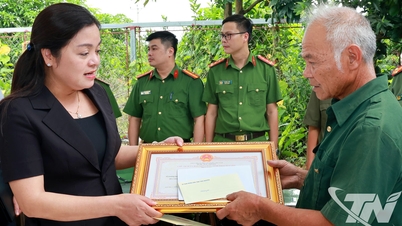






















Comment (0)